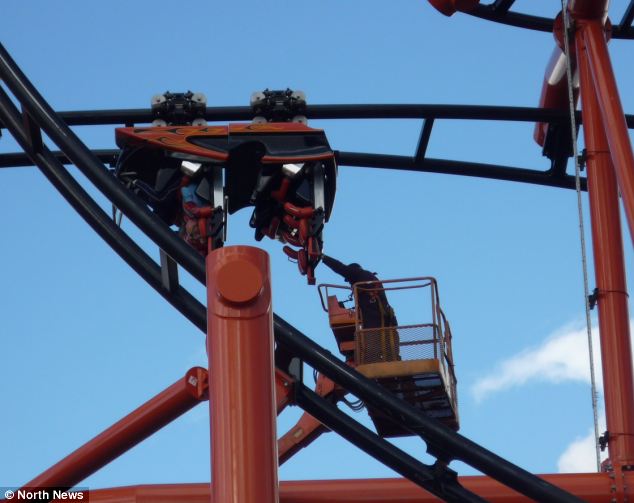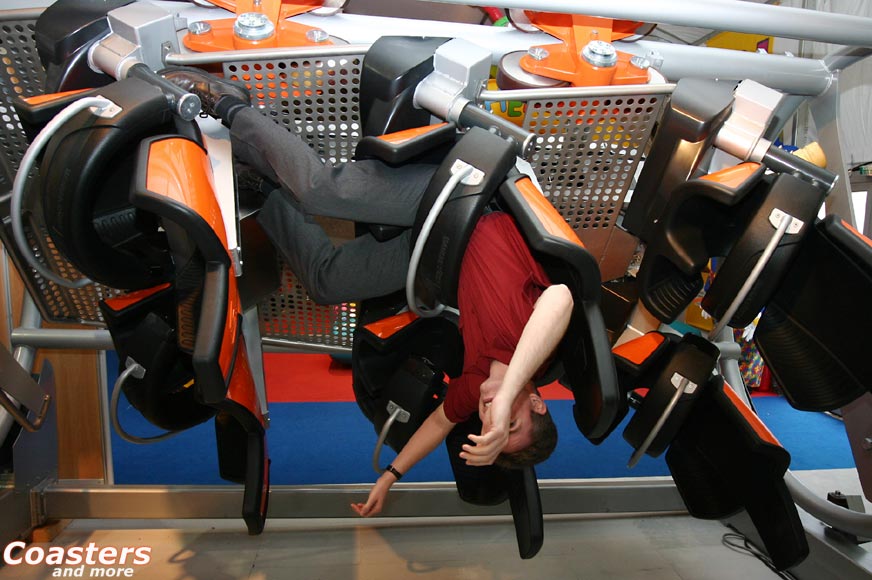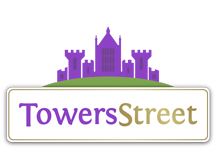Tim
TS Member
- Favourite Ride
- Air / Blue Fire
This is a spin off from the recent Lap Bar or Over The Shoulder Restraint (OTSR) debate that is going on in the Secret Weapon 7 topic. I thought a little history lesson might be revealing but didn’t want to drag that topic too far off topic.
Before I start I should note that I count a lap bar as any type of restraint that holds you by your lap. It can come over your head or from the side and in most cases won’t even be a bar but it’s simpler if I just call them lap bars. Ok? Then I’ll begin:
A Brief History of Inverting Lap Bars
Let’s start with the first modern inverting Roller Coasters in the 1970s. I have no doubt there were rides with lap bar inversions before these but let’s be honest they were probably death machines. So in 1975 Arrow built the first modern inversion and the first roller coaster to invert twice. Called Corkscrew the rides signature element was a double corkscrew (I know you must be shocked). It used OTSRs.
In 1976 Schwarzkopf (and Intamin) opened the Great American Revolution at Six Flags Magic Mountain. It had the first modern vertical loop and opened with lap bars:

This was a trend that Schwarzkopf maintained for quite a while until incidence like this happened:

Obviously this was a more recent event but I can’t find the famous old picture of a ride stuck upside down on its loop, so this recent example will have to do.
Parks got scared and got worried if the same thing could happen to them. Deming that Schwarzkopf very basic lap bar wouldn't be able to comfortably hold guests if this occurred most of them were phased out. Here's a more recent image of the Revolution, now with OTSR:

Jump forward to the year 2000 and it had become accepted knowledge that to go upside down you needed an OTSR. There were a few exceptions such as Premier Rides lap bar LIM coasters but not many.
However there were two companies that were actively trying to promote new restraint designs; S&S and Maurer Söhne. S&S were developing two new rides; the Screamin' Swing and the Fly Swat (or as we know them Rush and Slammer at Thorpe Park). Both were to have a new type of restraint with the intention of keeping it minimalistic. In the case of the Fly Swat it included half an OTSR in case the ride stalled mid rotation. Maurer Söhne went for something completely different with the X-Car. Supposedly the do anything car type which could actually hold riders upside down:

Neither design was very good. They were physically capable but not very comfortable. The X-Car in particular was let down by a lack of consideration towards ergonomics meaning that while it could hold someone upside down it wouldn’t be very comfortable.
It wasn’t until the late 2000’s that someone got the design right. But it wasn’t due to a manufacturer’s desire to create something different but a parks refusal to use OTSRs. I refer of course to Europa Park.
The park only had one thrill coaster, they wanted another and they wanted a looping ride. But they refused to use OTSRs. There are several reasons as to why (there’s a good First Drop article on the matter but I can’t seem to find it) but in part it was because the park owners Mack disliked anything that removed the freedom of the riding experience.
So they approached B&M, who had made their other thrill coasters but they were unwilling to alter their designs. The other manufactures said much the same and those that could offer the restraints they wanted produced far too low throughput rides for Europa Parks high standard. So they did what no other park could and built it themselves. The result should have been a disaster but instead we got Blue Fire:

^ Best Inversion ever?
In the past 3 years since then every major manufacturer has started developing their own lap bar rides. Premier Rides instantly returned with Sky Rocket. Gerstlauer followed with Dare Devil Dive and of course Iron Shark; the new classic Euro-Fighter design. B&M created the Wing Coaster and Vekoma introduce their new over the shoulder restraints, both have more in conmen with Blue Fires leg clamp design than an OTSR despite having vest sections. Even Intamin (who have spent the last 7 years refusing to build any big ride with lap bars) opened Lex Luthor: Drop of Doom and Skyrush with lap bars.
So there you have it. A very simplified version of the looping lap bars history to date.
Feel free to add more examples and your own thoughts. I made this fairly quickly based on my own understanding so other important examples may be missing.
Before I start I should note that I count a lap bar as any type of restraint that holds you by your lap. It can come over your head or from the side and in most cases won’t even be a bar but it’s simpler if I just call them lap bars. Ok? Then I’ll begin:
A Brief History of Inverting Lap Bars
Let’s start with the first modern inverting Roller Coasters in the 1970s. I have no doubt there were rides with lap bar inversions before these but let’s be honest they were probably death machines. So in 1975 Arrow built the first modern inversion and the first roller coaster to invert twice. Called Corkscrew the rides signature element was a double corkscrew (I know you must be shocked). It used OTSRs.
In 1976 Schwarzkopf (and Intamin) opened the Great American Revolution at Six Flags Magic Mountain. It had the first modern vertical loop and opened with lap bars:

This was a trend that Schwarzkopf maintained for quite a while until incidence like this happened:

Obviously this was a more recent event but I can’t find the famous old picture of a ride stuck upside down on its loop, so this recent example will have to do.
Parks got scared and got worried if the same thing could happen to them. Deming that Schwarzkopf very basic lap bar wouldn't be able to comfortably hold guests if this occurred most of them were phased out. Here's a more recent image of the Revolution, now with OTSR:

Jump forward to the year 2000 and it had become accepted knowledge that to go upside down you needed an OTSR. There were a few exceptions such as Premier Rides lap bar LIM coasters but not many.
However there were two companies that were actively trying to promote new restraint designs; S&S and Maurer Söhne. S&S were developing two new rides; the Screamin' Swing and the Fly Swat (or as we know them Rush and Slammer at Thorpe Park). Both were to have a new type of restraint with the intention of keeping it minimalistic. In the case of the Fly Swat it included half an OTSR in case the ride stalled mid rotation. Maurer Söhne went for something completely different with the X-Car. Supposedly the do anything car type which could actually hold riders upside down:

Neither design was very good. They were physically capable but not very comfortable. The X-Car in particular was let down by a lack of consideration towards ergonomics meaning that while it could hold someone upside down it wouldn’t be very comfortable.
It wasn’t until the late 2000’s that someone got the design right. But it wasn’t due to a manufacturer’s desire to create something different but a parks refusal to use OTSRs. I refer of course to Europa Park.
The park only had one thrill coaster, they wanted another and they wanted a looping ride. But they refused to use OTSRs. There are several reasons as to why (there’s a good First Drop article on the matter but I can’t seem to find it) but in part it was because the park owners Mack disliked anything that removed the freedom of the riding experience.
So they approached B&M, who had made their other thrill coasters but they were unwilling to alter their designs. The other manufactures said much the same and those that could offer the restraints they wanted produced far too low throughput rides for Europa Parks high standard. So they did what no other park could and built it themselves. The result should have been a disaster but instead we got Blue Fire:

^ Best Inversion ever?
In the past 3 years since then every major manufacturer has started developing their own lap bar rides. Premier Rides instantly returned with Sky Rocket. Gerstlauer followed with Dare Devil Dive and of course Iron Shark; the new classic Euro-Fighter design. B&M created the Wing Coaster and Vekoma introduce their new over the shoulder restraints, both have more in conmen with Blue Fires leg clamp design than an OTSR despite having vest sections. Even Intamin (who have spent the last 7 years refusing to build any big ride with lap bars) opened Lex Luthor: Drop of Doom and Skyrush with lap bars.
So there you have it. A very simplified version of the looping lap bars history to date.
Feel free to add more examples and your own thoughts. I made this fairly quickly based on my own understanding so other important examples may be missing.


